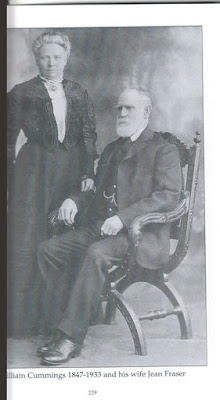John Fraser - A journey from Inverness to Goulburn.
Poverty, famine and epidemics in Scotland in the 1820s and 1830s caused
the first significant Scottish emigration to Australia. By 1837, when John Fraser's family immigrated to Goulburn, it appears they had already lost two of their children, two more died on the journey. What a heartbreaking start to their new life that must have been.
From the :Inverness Courier,
30 May 1838
‘Australian Emigration—Fort William’
After some months of expectation and anxiety, Dr. Boyter, the Government emigration agent for Australia, arrived at Fort William on x 8th current. The news of his arrival, like the fiery cross of old, soon spread through every glen of the district, and at an early hour on Monday, thousands of enterprising Gaels might be seen ranked around the Caledonian Hotel, anxious to quit the land of their forefathers and to go and possess the unbounded pastures of Australia. . . . While we regret that so many active men should feel it necessary to leave their own country, the Highlands will be considerably relieved of its over-plus population.
Scotland
I do not know who John Fraser's parents were, but it is likely they were also from Inverness in Scotland, as people did not move around a lot in those days, unless they were immigrating. I know from census information that John Fraser was born about 1809 in Inverness, Scotland.
The Fraser Clan had traditional land in Inverness-Shire, Scotland.
Fraser Castle
|
Family life
John Fraser and Ann McGlashan married in Longforgan, Perthshire, Scotland on 9th May, 1831, and we know this from the Scottish Marriage records. John was aged about 22, and Ann 21 years.
The family lived in Inverness according to the 1851 Census. They had five children before they immigrated to Australia. The children were born in Longforgan, and Inverness in Scotland, but when they arrived in Australia, only their daughter, born just before the journey (Ann) was still alive.
We know from the immigration records that both John and Ann could read and write, and that they were Protestants. John's occupation is listed as Grieve, which means he was a sheriff or bailiff in Scotland. There are a few entries in the NSW Government Gazette naming a Constable Fraser in the Goulburn area, but it is not clear if it is my John Fraser - could be though!
It appears the family went straight to Goulburn to live, in a little town called Bungonia, and this is where my GG grandmother, Jessie Fraser was born. The couple went on to have another 6 children, making it 12 in all.
Here is a picture of their daughter Jane Fraser and her husband William Cummings:
and, this (sorry about the quality) is their son Robert Fraser and his wife:
John Fraser died on 11th April, 1883, and his wife 5 years later. They are both buried at the Old Goulburn Cemetary, Goulburn, NSW, AUS. I know nothing of their life together other than they lived and had their family in the Goulburn area, hopefully more will come to light in the future.
Transcription:
" Anne Fraser
11
December 1888, 80y. Wife of John Fraser. Leaving 3 sons and 5 daughter
Her beloved husband, John Fraser
11
April 1883, 74y. Native of Fifeshire, SCT., Husband of Anne Fraser.
James Fraser
13 June 1907,
56y. 3rd son of John & Anne Fraser."
-------------------------------























